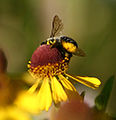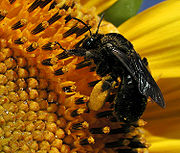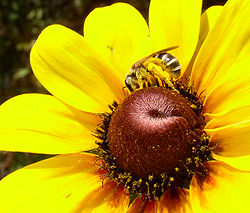
Scopa (biology)
Encyclopedia

Bee
Bees are flying insects closely related to wasps and ants, and are known for their role in pollination and for producing honey and beeswax. Bees are a monophyletic lineage within the superfamily Apoidea, presently classified by the unranked taxon name Anthophila...
that form a pollen
Pollen
Pollen is a fine to coarse powder containing the microgametophytes of seed plants, which produce the male gametes . Pollen grains have a hard coat that protects the sperm cells during the process of their movement from the stamens to the pistil of flowering plants or from the male cone to the...
-carrying apparatus. In most bees, the scopa is simply a particularly dense mass of elongated, often branched, hairs (or setae) on the hind leg. When present on the hind legs, the modified hairs are, at a minimum, on the tibia, but some bees also have modified hairs on the femur and/or trochanter. A few bees have, in addition to the leg hairs, many modified hairs on the ventral surface of the abdomen which are also used in pollen transport; there is one family of bees, Megachilidae
Megachilidae
The Megachilidae are a cosmopolitan family of solitary bees whose pollen-carrying structure is restricted to the ventral surface of the abdomen...
, in which the modified leg hairs are absent, and the scopa is limited to the abdominal hairs (see photo). In the familiar honey bee
Honey bee
Honey bees are a subset of bees in the genus Apis, primarily distinguished by the production and storage of honey and the construction of perennial, colonial nests out of wax. Honey bees are the only extant members of the tribe Apini, all in the genus Apis...
s and bumblebees, the scopa is replaced by a structure known as the corbicula
Pollen basket
The pollen basket or corbicula is part of the tibia on the hind legs of the four related lineages of apid bees that used to comprise the family Apidae: the honey bees, bumblebees, stingless bees, and orchid bees...
.
There are other various types of modified hairs on bees that are used to remove pollen, floral oils, or other chemicals from plants, and these can be on the face, mouthparts, or the front or middle legs, but these are not classified as a scopa; the term is explicitly restricted to hairs used to transport pollen. There are some bees which transport pollen internally in the crop, and these lack a scopa, as do cleptoparasitic bees, which do not gather their own pollen.



